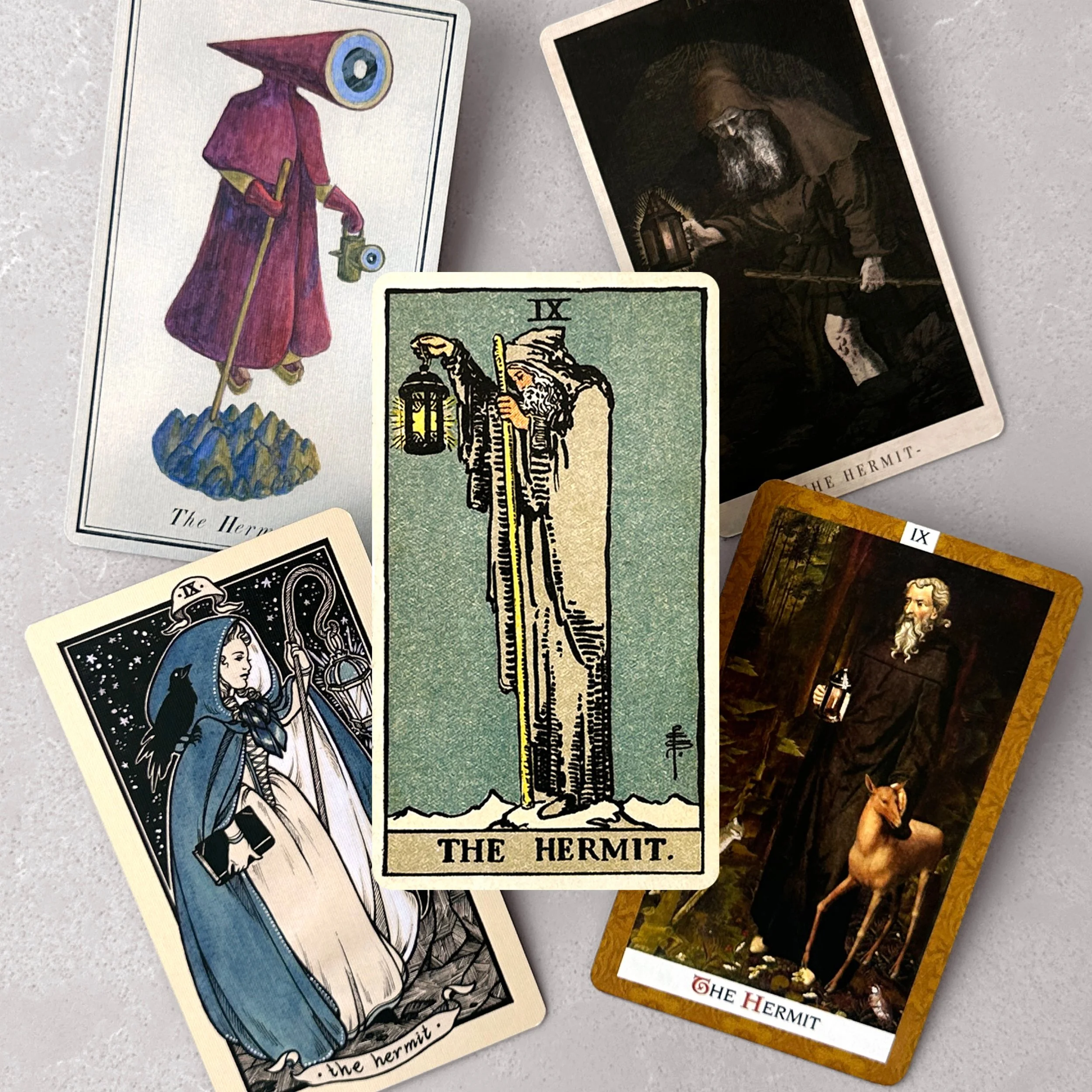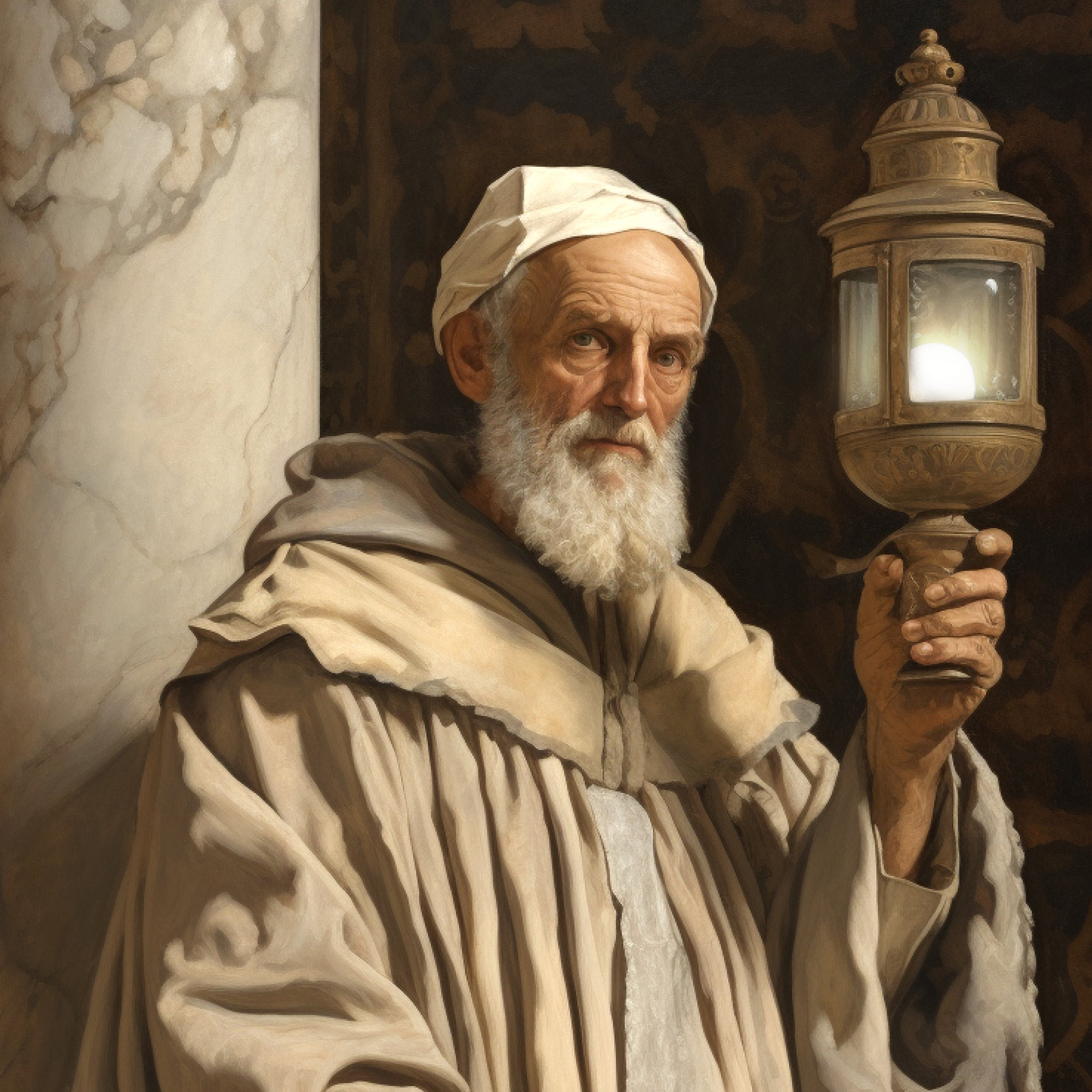How to Light a Lantern
Shining a little light on The Hermit
"We can easily forgive a child who is afraid of the dark; the real tragedy of life is when men are afraid of the light." — Plato
When my husband and I first started dating, and I began to share my interest in Tarot with him, we discussed specific cards that we identified with or found striking. Naturally I informed him about my passion for the Page of Cups and how I came to select it as my significator card many years before, along with other cards that I found impactful. When I asked him what his favorite cards were, surprisingly he only had one: The Hermit. At that time he had a basic understanding of Tarot and a working knowledge of the card itself—its meanings, influences, and overall energy. However, in my head, I was convinced that he was more of a Knight of Pentacles, a King of Cups, or even a Magician, but most certainly not The Hermit!
As our relationship grew, I came to understand why my husband identified so strongly with The Hermit. Although he can be extroverted when the occasion calls for it, he is a tinkerer at heart, drawing his energy from within to go exploring on his own. Whether pouring himself into a new, super-complicated New York Times recipe, shopping to the flower market to create a stunning floral arrangement, or fully taking apart our stand-mixer to find the technical reason for its apparent demise (KitchenAid stand mixers, amirite?), my husband thoroughly enjoys taking time for himself to dig deep and uncover newness that lies within.
It's funny—as I've grown with the Tarot over the past year, I've started to see myself in a similar, albeit more extroverted, way. As my appetite for both teaching and studying Tarot has grown, social media has become a crucial tool in connecting me with other Tarot enthusiasts from around the world. While the connections grew, so did the informational exchange. Not only have I been able to share what I have learned, but I have also been inspired and influenced by the knowledge of others.
I believe that every card has a counterbalance in the Tarot—a partner so to speak. While my husband's affinity for The Hermit became his representative, The Hierophant increasingly became one of my favorites. Both of these characters, while each on a quest for knowledge and truth, take their learnings in opposing directions. One silently withdraws to study on their own while the other steps forward to learn collaboratively with others. The energies we bring to our relationship are complementary, not conflicting, allowing us to fully lean on one another when the other needs support.
Recognizing ourselves within the Tarot can be a very powerful experience. Whether we've been studying the cards for years or just picked up our first deck yesterday, seeing ourselves in a Tarot character, figure, or archetype can help us to understand and express ourselves more fully. Sometimes, these moments of recognition come suddenly, jolting us awake to a part of ourselves we may have never seen before. The word arcana has a Latin root meaning "secret" or "mystery," and more often than not, the Tarot loves to reveal those mysteries to us—especially when they're about us or the ones we love.
The cards selected to explore The Hermit help us step into his solitary dominion. With lantern raised, each of these renditions shines a light on the one who prefers to be alone: the Smith-Waite Centennial by Arthur Waite and Pamela Colman Smith, the Carnival at the End of the World Tarot by Kahn & Selesnick, the Fyodor Pavlov Tarot by Fyodor Pavlov, the Terra Volatile Tarot by Credo quia Absurdum, and the Golden Tarot by Kat Black.
IX. The Hermit. Clockwise from top left: the Carnival at the End of the World Tarot by Kahn & Selesnick, the Rider-Waite Tarot (Waite-Smith) by Arthur Waite and Pamela Colman Smith (U.S. Games Systems, Inc.), the Terra Volatile Tarot by Credo quia Absurdum, the Golden Tarot by Kat Black (U.S. Games Systems, Inc.), and the Fyodor Pavlov Tarot Tarot by Fyodor Pavlov (U.S. Games Systems, Inc.).
Gender within the confines of the cards, especially its expression in the traditional Rider-Waite-Smith deck, is pretty fluid. Some figures in the Major (eg. Temperance, Justice, The Chariot) and Minor Arcana (eg. Two of Cups, Seven of Pentacles, Page of Swords) are relatively androgynous in their appearance. By including gender-neutral imagery, we are more likely to engage in self-reflection, exploring how our feelings mix with the meaning of the card. It can prompt querent to question and examine their own assumptions, too, leading to growth and expanded perspectives. Writer and Tarot consultant Mary K. Greer notes that the cards speak “a language that transcends gender, inviting us to explore the depths of our souls…” However, The Hermit is almost always unmistakably depicted as an older, cis-gendered male.
Although the archetype of the hermit has morphed over the centuries to include female and even non-human depictions (as seen in the Fyodor Pavlov Tarot and the Carnival at the End of the World Tarot), the history of the ancient recluse is one steeped in maleness. Not only were there accounts of men withdrawing from society to seek spiritual enlightenment in the deserts of Ancient Egypt, but the Ancient Greek philosopher Diogenes became notable for his own retreat, too. He rejected material possessions and embodied the ideals of simplicity and self-sufficiency of the time—all while living in a barrel! He was even known to carry a lantern during the day, supposedly to help him look for “an honest man”. (cough, cough, HERMIT.)
It should come as no shock that in early Christianity (not particularly well-known for their inclusion of females) hermits emerged as individuals who sought to live a life of devotion and prayer in isolation. During this time, desert fathers, also known as anchorites, sought solitude in the deserts and were revered for their bachelor lifestyles, self-discipline, and spiritual insights. These men were so good at disappearing it inspired the establishment of other monastic communities and the development of Christian monasticism.
Who knew that by simply being alone you could become so wildly popular?
Even though the history of the hermit does have a staunch male construct, the idea of a hyper-focused, spiritually curious, extremely self-disciplined individual does transcend gender as Mark K. Greer mentioned.
Whether male or female, human or non-human, The Hermit action figure will always come complete with at least one accessory: a lantern. Before researching the images of each card in an essay, I make sure to look at each rendition in my own collection. Of course there are overlaps, differentiators, and some VERY interesting interpretations from card to card and character to character, however, The Hermit was NEVER without a lantern.
The Hermit created with the help of artificial intelligence.
History has given us quite a selection of lanterns over the millennium. Clay, paper, metal, glass—almost any material that one can think of has been used to contain light. Of course, they have become synonymous with illumination, guidance, and direction, but lanterns have also become associated with enlightenment, inspiration, and the pursuit of truth. Their importance to the human race stemmed from the need to see through the darkness—an aid to help us find our way through the black.
While one hand maintains the light, The Hermit’s other hand traditionally holds a staff, rod, or stick. Perhaps this could be translated as a Wand as well, and rightly so. While the suit of Wands is associated with the element of fire, the same element fills The Hermit. Although he might not seem like the most lively of individuals, the drive and passion from within ignite his journey forward. Yes, he is a little older in years (denoted by his graying or white beard), but this is a mere detail— never standing in his way to enlightenment. In fact, the rod only stabilizes him more, especially when challenged by the terrain or even a passer-by who disrupts his path with a “Hey! Where are ya goin’ old man?”. The Hermit, with the hood up and eyes cast down, will stop at nothing to get to the truth.
I can’t speak for my husband on the matter, but I'm certain as time passes the cards I resonate with will naturally shift. It's amazing how a symbol that once represented spiritual oppression (The Hierophant), has now become a newfound fascination. Perhaps it’s the unconscious influence of those “desert fathers” that sparked this change. And sure, while I didn’t venture into the desert to commune with the Divine, I did quietly reassessed my connection with the card, drawing inspiration from the wisdom and knowledge shared by fellow Tarot enthusiasts.
And just like The Hermit's unwavering determination to seek enlightenment and find answers within, our relationship with the Tarot is an ever-evolving journey of self-discovery, too.


